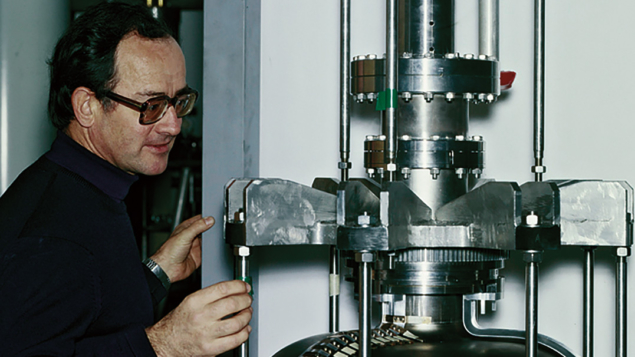
Experimental physicist Herbert Lengeler, who made great contributions to the development of superconducting radiofrequency (SRF) cavities, passed away peacefully on 26 January, just three weeks short of his 90th birthday.
Herbert was born in 1931 in the German- speaking region of Eastern Belgium. He studied mathematics and engineering at the Université Catholique de Louvain in Belgium, and experimental physics at RWTH Aachen University in Germany. He worked there as a scientific assistant and completed his PhD in 1963 on the construction of a propane bubble chamber, going on to perform experiments with this instrument on electron-shower production at the 200 MeV electron synchrotron of the University of Bonn.
In 1964 Herbert was appointed as a CERN staff member in the track chamber and accelerator research divisions. He was involved in the construction, testing and operation of an RF particle separator for a bubble chamber. In 1967 he then joined a collaboration between CERN and IHEP in Serpukhov, in the Soviet Union, within which he led the construction of an RF particle separator for both IHEP and the French bubble-chamber Mirabelle, which was installed in the same institution.
In 1971 the value of SRF separators for improved continuous-wave particle beams was recognised. This necessitated the use of SRF systems with high fields and low RF losses. Since a development programme for SRF had just been initiated at the Karlsruhe Institute of Technology in Germany, Herbert joined the research centre on behalf of CERN. In the following pioneering period up to 1978, he led the development of full-niobium SRF cavities operated at liquid-helium temperatures, with all required auxiliary systems.
The success of the SRF separator led to ambitious plans for upgrading the energy of LEP at CERN, which were initiated in 1981. A first SRF cavity with its auxiliaries (RF couplers, frequency tuner, cryostat) was installed and successfully tested in 1983 in the PETRA collider at DESY in Hamburg. Following this, in 1987, an SRF cavity with all auxiliaries and a new helium refrigerator was installed and tested at CERN’s SPS. In parallel, Herbert orchestrated the development of niobium sputtering on copper cavities as a cheaper alternative to bulk niobium. Gradually, additional SRF cavities were installed in the LEP collider, resulting in a doubling of its beam energy by the end of its running period in 2000.
From 1989 onwards, Herbert gradually retired from the LEP upgrade programme and devoted more time to other activities at CERN, such as consultancy for SRF activities at KEK, DESY and Jefferson Lab. In 1993 he was appointed project leader for the next-generation neutron source for Europe, the European Spallation Source, a position he held until his retirement from the project and CERN in 1996.
Herbert was always interested in communicating his experience to younger people. From 1989 to 2001 he frequently gave lectures on accelerator physics and technology as an honorary professor at the Technical University of Darmstadt in Germany. In 1998 he was awarded an honorary doctorate from the Russian Academy of Sciences for his contribution to the CERN–IHEP collaboration.
Herbert was an enthusiastic musician. He had been married since 1959 to Rosmarie Müllender- Lengeler, and the couple had four children and 10 grandchildren.





